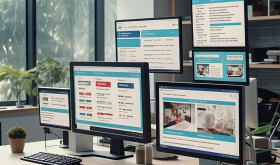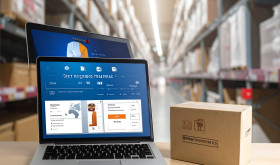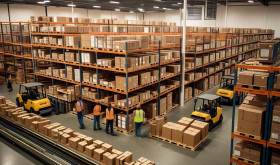
In today’s fast evolving global economy where supply chain productivity is key, logistics companies rely more on cutting-edge technology solutions to improve their operations. One solution that’s become essential is the Transport Management System (TMS). A TMS is software that helps plan, carry out, and optimize how goods move, both in and out. It makes sure the process is productive follows rules and keeps costs down. As companies face higher demands to deliver faster be more open, and control costs better, TMS has changed from just an operations tool to a strategic asset.
Why TMS is Essential in Modern Logistics
The logistics industry deals with complex operations. These involve coordinating multiple stakeholders, managing vast amounts of data, and overcoming challenges. These challenges include fluctuating fuel prices, driver shortages, and changing regulations. A TMS tackles these issues by automating manual processes, cutting down errors, and offering real-time insight into supply chain activities. Here’s why TMS has become crucial for logistics companies:
Better Efficiency and Productivity: TMS automates processes that eat up time, like route planning, load optimisation, and paperwork. By cutting the need for manual work, TMS lets companies zero in on core activities. This leads to better productivity and more effective operations.
Saving Money: Logistics operations always aim to cut expenses. TMS helps do this by finding the best routes, combining shipments, and getting better deals with carriers. It has an impact on lowering fuel use, cutting out pointless stops, and reducing empty trips. This means TMS can bring down shipping costs.
Better Customer Care: In today’s online shopping world, buyers want quick, dependable, and clear delivery services. TMS offers live tracking and updates, which companies can share with customers to make their experience better. Also, TMS makes sure packages arrive when they should, which is key to keeping customers happy and coming back.
Compliance and Risk Management: Getting around the tricky world of logistics rules can be tough. TMS helps companies follow the rules by handling regulations, paperwork, and permits. It also cuts down on transportation risks by giving insights into how drivers are doing, how safe routes are, and if they’re meeting green standards.
Data-Driven Decision Making: A TMS gathers useful data that can be looked at to spot patterns, things that aren’t working well, and chances to get better. By using this information, logistics companies can make choices based on data that make their work better, boost profits, and get ahead of the competition.
Key Features of Transport Management Systems
To get a full grasp on how TMS adds value, we need to look at its main features and how they boost logistics operations. Here are some key TMS features:
- Route Optimisation and Load Planning
TMS shines with its route and load planning optimisation. This feature crunches numbers and uses live data to find the best routes. It looks at things like distance, fuel use, traffic, and delivery windows. For loading, TMS makes sure trucks are packed to the brim, cutting down on trips and costs. This speeds up deliveries and saves money by reducing empty miles.
- Carrier Management
TMS has strong carrier management features, helping companies handle relationships with many carriers. It makes it easy to compare carrier prices, delivery times, and how well they perform, letting companies pick the best carrier for each shipment. Also, TMS can choose carriers based on set rules, like cost, service quality, and how much they can handle, making sure shipments are dealt with by the most fitting carrier.
- Real-Time Shipment Tracking and Visibility
Seeing where things are is super important in today’s shipping world, and TMS lets companies keep tabs on their stuff in real time from start to finish. This means businesses can watch where their goods are going, spot holdups before they happen, and jump in to fix problems before they get big. Being able to see everything also helps give customers a better idea of when their orders will show up, which is key to keeping them happy.
- Order Management and Inventory Integration
TMS has the ability to work together with order management and inventory systems, creating a single platform to handle the whole order fulfilment process. This teamwork makes sure inventory counts are kept up to date as items are picked, packed, and sent out, helping to avoid running out of stock or having too much on hand. It also helps warehouse work and transportation to sync up better, cutting down on wait times and boosting order accuracy.
- Automated Documentation and Compliance Management
Paperwork plays a big role in logistics operations. This includes shipping labels, bills of lading, customs declarations, and compliance reports. A TMS makes creating, sharing, and storing these documents easier. This cuts down on office work and helps prevent mistakes. The system also helps businesses follow international trade rules. It does this by handling duties, tariffs, and required paperwork. This helps companies avoid expensive fines and holdups.
- Performance Analytics and Reporting
TMS offers top-notch analytics and reporting tools that let companies gauge how well their transportation operations perform. Companies can track and examine key metrics like delivery times, costs, carrier performance, and customer satisfaction to spot areas that need work. By shedding light on what’s going well and what could use a tune-up, TMS gives companies the power to keep fine-tuning their logistics game plans.
- Scalability and Customisation
As companies expand, their logistics needs change. A TMS is built to grow and be tailored, giving companies the chance to mould the system to fit their unique needs. Whether it’s bringing on new carriers, linking up with new systems, or gearing up to handle more shipments, TMS offers the flexibility to keep pace with the business as it grows.
- Sustainability Management
As companies focus more on sustainability, many TMS solutions now offer features to help businesses cut down their carbon footprint. These include finding the best routes to use less fuel, working with green-friendly carriers, and showing how logistics operations affect the environment. By making sustainability a part of transportation planning, TMS helps companies reach their environmental targets and follow regulations.
Conclusion
Transport Management Systems have changed a lot in the logistics world. They’ve gone from basic transportation tools to key parts of supply chain strategy. These systems now have cool features like finding the best routes, tracking in real-time, handling rules, and looking at data. This means companies can work better, spend less, and serve customers better. As businesses deal with tricky global shipping, having a strong TMS will help them stay in the game, keep customers happy, and do well in the long run.










